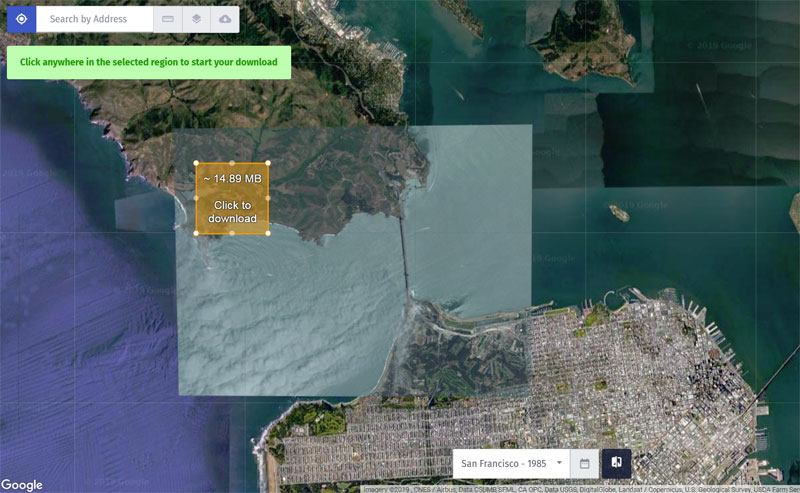ATLIS Geomatics (http://www.atlisgeo.com/) is a major Canadian provider of airborne imagery and LIDAR data. They are also a sales channel partner for several large satellite imagery providers.
Typically, under contract, they will hire the planes and equipment necessary to survey an area, such as a city, municipality etc.
Traditionally, they have been delivering the resulting data to their clients on hard drives or other physical media. They would like to move to an online delivery method where clients can have an account, buy credits and be charged by the GB downloaded, or access the data directly in their own applications, via web services.
All of this access must be subject to access control and quotas defined by subscription plans.
ATLIS approached CubeWerx to provide a platform that could accommodate their business model and technological needs.
Challenges
- The terabytes of data must be organized on the server in such a way as to be made quickly available to web mapping applications.
- The system must be able to accept “clip-zip-and-ship” requests for any region that an Atlis client wants to download and respond either immediately, or with an email and download link for larger requests. This may mean stitching many independent source images into a new image of the size and dimensions requested.
- The system must implement auditing and quota management, such that quotas based on client subscriptions can be enforced. It must be flexible enough to permit many different billing models, such as billing per pixel, per square km, etc.
- The system must integrate with the client’s current web portal, which uses WordPress for authentication and WooCommerce for e-commerce/purchasing.
The CubeWerx Approach
After working closely with Atlis to further refine their target product offering, CubeWerx proposed a self-managed installation of the Stratos Geospatial Platform, coupled with a custom web application for data delivery. The client had lots of experience dealing with geospatial data in general, so it was felt that a fully-managed service was unnecessary, which proved to be the case.

Screenshot of custom data download portal
The application ]would be hosted on Amazon’s EC2 Cloud infrastructure for its obvious advantages in cost, robustness and scalability of services. Data would be stored in S3, Amazon’s triple-redundancy object store.
Getting the data in
Deployed on the client’s own Amazon’s AWS cloud infrastructure, the Stratos Platform offered a convenient browser-based interface for building large imagery mosaics from data collections uploaded to cloud storage. The client just had to get their data into a “bucket” in Amazon’s S3 storage, and then point Stratos to the bucket’s contents and tell it to publish the data. A few minutes later, a new mosaic was fully indexed, map tiles created and its web map services ready to go.
Open Web Services Out-of-the-Box
At this stage, the service was fully operational, and clients could connect to the web service end points with any standards-compliant web mapping or desktop application. However ATLIS also wanted to provide an online portal where users could browse the available data, select an arbitrary area, and then download it, in its original coordinate system.
Custom portal
Although the CubeWerx web services support the download capabilities required out of the box, a custom portal was required to align with the desired look and feel of the Altis website, as well as to integrate with their eCommerce platform. Working to the customer’s specifications and templates, it was a matter of a few weeks work to complete this application, since most of the heavy lifting was handled by the back end services that are already a part of the Stratos platform.
Authentication
Stratos uses a secure token-based authentication scheme, and a role-based access control gateway to secure services. However the rest of the client’s offering depended on the WordPress and WooCommerce platforms. There was a disconnect here, and a possible integrity issue if these two authentication methods were managed separately. CubeWerx worked with Atlis to automatically sync the authentication and roles managed by WordPress to their internal counterparts in the CubeWerx system. This allowed Atlis to create user data plans in the WooCommerce software that were connected to roles in the CubeWerx system to control access to the services.
Quotas
Now Atlis had a data management solution, and a user-facing portal. They now needed to track usage and enforce quotas based on subscriptions. The Stratos platform automatically tracks usage of all the web services it manages, down to the pixel level. These analytics feed into a system of quotas that can be attached to any CubeWerx user or role. Combined with the WooCommerce functionality described above, this closed the loop on the requirement to provide subscription based plans to customers.
Access Control
A high degree of flexibility was required in controlling how different users could access the service. Some levels of access might only be permitted to download low-resolution versions of the available data. A free tier might receive data with a watermark. Covering all these permutations with different services would not be realistic.
Fortunately the Stratos platform could handle these requirements via it’s access control module. Different rules could be applied to the same web services, depending on a user’s identity. Using the Stratos web dashboard, managers could edit these rules to create custom web services that align to the limitations of each subscription plan, without having to duplicate any of the data or services. Watermarks, or reduced resolution filters could be applied on the fly by the web services, driven by user identity tokens.
Results
Atlis now has two new sources of revenue, by creating new ways for their clients to use their data, and by revitalizing their back catalog to provide historical imagery for comparison to newly acquired data through web services.
Atlis clients can sign up and purchase subscriptions directly on the website to either download raw data or consume it through web services like OGC WMS (Web Map Service) and WMTS (Web Map Tile Service).
Going forward, Atlis has made the transition away from a declining sales model (direct physical shipment of data) to a growing one (Web Services). This will help them achieve even more success in the future.


